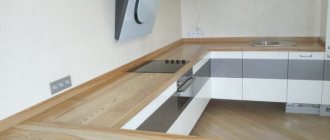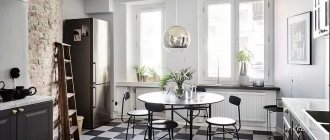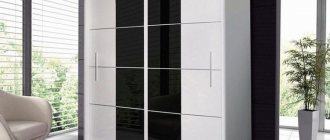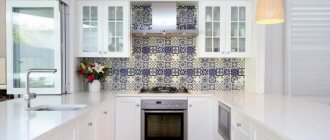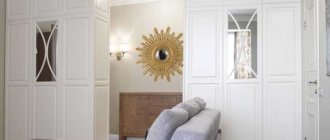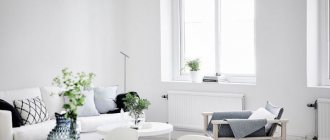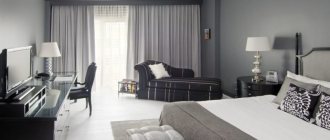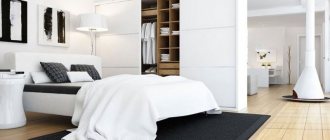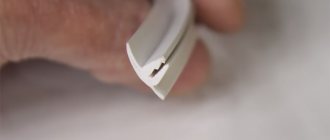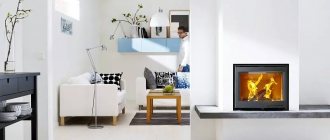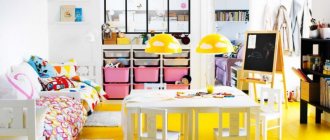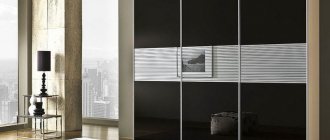The older generation remembers well that the renovation of an apartment (private house) was carried out for the sake of “renovation”. It was lucky to find imported wallpaper or paint, good flooring. And the owners did not care at all that the finishing materials often did not combine with each other. The main thing is that they were there, they were able to “get” them. These times have sunk into oblivion. Today, even baseboards play an important role in the interior. But another problem arose: the variety of choices in color, shape, material and texture leads the buyer to a dead end.
And if there was no ready-made solution for decorative strips, situations arise when the purchase is either postponed for a couple of days (how can we not recall the story of Buridan’s donkey, who died of hunger between two armfuls of hay - the choice turned out to be so difficult), or he chooses something completely wrong? . In this case, designers suggest buying white skirting boards for the floor in the interior - it’s almost impossible to make a mistake. The editors of the StroyGuru portal decided to find out why this advice is good for any design style.
Rules for decorating premises
When choosing a white baseboard to decorate a room, it is important to remember the rules and advice from designers that will help you avoid mistakes
- If the flooring of the room is white or light shades, then you cannot do without expensive white skirting boards made from wood. Cheap finishing materials can ruin the overall impression of the renovation. It is these seemingly insignificant details that form the overall effect of the interior.
- White window frames and white baseboards always go well with dark floors and doors in dark shades. Such an interior can withstand even the most daring decorative techniques and color combinations in decoration.
- Light doors and a white baseboard will visually expand the room if the flooring is made in dark colors and the walls in light colors. In large rooms, this option will not be successful, since the feeling of comfort will be lost. Creating comfort in this case will be very difficult even when using the most cunning decorative techniques.
- Walls of bright and rich colors love white baseboards. In this option, their color will be deeper and do not require additions. But, as a rule, such design of premises has its own specifics. It is better to use it in non-residential functional rooms intended for active pastime. For the bedroom it is better to use a calmer finishing option.
- If there is a need to visually reduce the geometry of the room, then the white color of the border in combination with dark doors will perfectly cope with this task. This option will harmoniously fit into large rooms with high ceilings, columns and moldings.
Rules of good manners
Experienced designers give a number of recommendations for combining white skirting boards and other room decoration elements.
First rule: light floor and baseboard
Decorating the floor with light finishing materials is a good solution for a small room. Typically, this flooring is used in classic, Provence, and Scandinavian styles. Thanks to the light shades of the flooring and baseboards, the interior will not look overloaded; on the contrary, it will be light and cozy. An example is the bleached oak floor and planks to match it.
Second rule: dark floor and door
It happens that the interior requires the use of dark floor coverings and similar door panels. For skirting boards and trim in such a situation, it is worth choosing light-colored materials of the same texture. It is advisable to use a floor plank at least 80 mm wide.
Third rule: dark floor, light door
It is recommended to purchase light doors if the floor is finished with dark material and the room is small. Light wallpaper, coupled with a white baseboard and the same door panels, will visually make the room lighter and raise the ceiling. Instead of white, you can choose light wood, ivory, beige, or cream for the baseboard.
Fourth rule: a bright door and a mahogany-colored floor
To make the interior of the room more impressive, you can use finishing materials of non-standard colors, which themselves serve as decorative elements. The easiest way is to decorate the floor in a bright, deep color and diversify the picture with a richly colored door leaf. A light baseboard will help complement the interior. This type of design is recommended for the kitchen, hallway, nursery, and hall.
Installation nuances
The main problem areas when installing skirting boards are the corners and joints along the length. Each room has four internal corners, the geometry of which often differs from 90°. In addition, heating registers are usually located in a niche under the window, and these are two more external and the same number of internal interfaces in which the decorative strip will have to be cut.
Manufacturers produce skirting boards with a maximum length of 2.5 m, since this size is the most convenient for transportation. Therefore, on at least two walls in the bedroom, hallway, and living room, it will have to be increased in length. The joint at an angle in width is considered the most inconspicuous.
Fillet joint lengthwise
Then you need to consider the way the fillet is fixed to the wall. Polymer materials, soft tape and tiles are most often glued to wall cladding. The wooden moldings are fastened with self-tapping screws, the heads of which are painted over. The MDF plank has a longitudinal inclined groove on the reverse side and fits onto fastenings screwed around the perimeter of the walls.
Cut the material with a miter saw.
It is most difficult to trim wood and MDF in corners, since chips and irregularities are difficult to putty on a curved surface with shaped milling. Polymers are cut with a knife, but in any case you will need at least a miter box to do the work yourself. Ideally, you should cut the baseboard with a miter saw.
Trimming the plank in a miter box.
Therefore, the installation of MDF skirting boards, which occupy the top line of the rating, is most often entrusted to professionals who initially have such equipment.
How to choose
Skirting boards cannot act as an independent interior detail. They are always chosen with an eye to some larger element that is located next door. For example, they focus on the color of the door, window, furniture, and floor shade. The material also matters. Wood is universal and can be combined with any walls and floors. Budget plastic is suitable for linoleum, laminate and carpet. Ceramic and stone skirting boards look organic only with marble, granite and tiles.
Match the color of the walls
A plinth matching the color of the walls allows you to erase or emphasize the boundary between them and the floor. In the first case, so that the surfaces do not merge completely, select a “belt” that is a shade lighter or darker. This technique is a favorite among designers, since the option of combining tones close in the spectrum is considered a win-win.
In rare cases, walls, door frames and baseboards are selected in the same color. The solution is very fresh and extravagant, therefore suitable for bold modern styles. To emphasize the boundary between the floor and the wall, choose either a neutral shade of the baseboard or a bright one. The latter is rare, since in the color scheme of the element they still give preference to nut, beige, chocolate and coffee with milk. It is not recommended to choose a baseboard that matches the color of a wall decorated with a covering with colorful patterns. The boundary between the floorboard and the floral wallpaper should be strict and neat.
Match the color of the floor
According to traditional canons, the plinth is selected to match the shade of the floor covering. Ideally, it should be a couple of shades lighter or darker, depending on the color transition to the wall. The combination of the same shade is considered a win-win
In this case, it is not so important whether the baseboard is combined with the tone of the wall covering or window and door openings. Everything above should be combined with the fillet, and a neat, plain bottom will remain aside
Match the color of doors and windows
Designers recommend choosing baseboards to match the color of door and window frames only if they are made of wood. This element will help to gently integrate into the interior openings of a different shade that look unbalanced in the overall palette of colors. For example, in a room with dark flooring and walls, white doors will find support in the form of a baseboard of the same color.
White edging in the interior
White plinth ennobles the interior, making it more refined and elegant. It is universal and organically fits into any stylistic solution. A neutral color allows you to harmoniously add white doors or windows to a dark environment. With such a plinth, any interior will look airy and light. White edging will highlight the high walls. The effect of this technique is doubled if the ceiling is decorated with the same fillet. Although the white baseboard is new, it seems like it was created for a classic style. The element will add a refined touch to the luxury of the interior. However, it is worth considering that light-colored edging will have to be washed systematically, since the surface is easily soiled, and the floor is not the cleanest place in the house.
Colored contrasting floor frames
Contrasting colors in baseboard panels are a bold innovation in recent years. They are ideal for extraordinary, creative interiors decorated in modern styles. Since the flooring is usually done in neutral colors (shades of brown, black, gray), skirting boards are selected to match the furniture and individual decorative details. In strict classics, such an option is difficult to imagine, but fusion, futurism, eclecticism, and ethnicity, which are flexible in relation to innovations, will calmly accept such a bright experiment. A living room in a mixed style with an orange-violet color scheme will be emphasized by a defiant lilac baseboard. A dark environment will be enlivened by a contrasting strip of red, yellow or green. Eye-catching black and blue panel curtains against the background of light walls and a neutral floor will find support in the blue baseboard.
Choosing a frame for the floor
White floor plinth is a bold solution in the interior. White doors and baseboards visually refresh the room and give it lightness, especially in combination with a black floor. You need to think through the color, location and shape of the planks at the design stage, otherwise the details may turn out to be incompatible with each other. It is important that the color and texture of the plinth harmonizes well with:
- furniture,
- walls,
- decor.
The material for making fillets is no less important than color. For example, when decorating a room in a country style, it is better to purchase wooden planks; for high-tech, products made from modern plastics are suitable; for baroque, MDF or plastic ones with a “tiled” pattern are suitable. The size of the room also plays a big role. Light baseboards are ideal for small rooms as they visually expand the boundaries.
You can also use light planks to match the walls: beige, milky, and cream options look especially good. In general, fillets should not be too conspicuous - they should become a harmonious interior detail that corresponds to the overall concept. If you plan to pass wires through the baseboard, you need to choose products with a cable channel.
Plank to match the color of the flooring
This option for selecting fillets is a real classic. Wooden skirting boards began to be used precisely when wooden floors came into fashion. In addition to aesthetics, using the same material for the floor and planks will provide another important advantage. The same expansion coefficient will not allow the products to deform when compressed and stretched. This will reduce the likelihood of cracks or wood splitting.
Laminate or linoleum floors harmonize perfectly with plastic skirting boards of the corresponding colors. Dark flooring can be complemented with white strips for contrast, while installing doors of the same color or other trim elements. In any case, you need to purchase finishing for the floor and fillets at the same time, and you need to compare their tones only in natural light - artificial light distorts the shades.
We select the baseboard to match the color of the walls
Often the wall covering has a texture that is completely incompatible with the appearance of the fillets. It is easy to select planks for walls only if the wallpaper does not have a complex pattern or texture. A white plinth for completely white walls is only suitable if you do not plan to place a visual emphasis on it, when the product will play an exclusively practical function.
Planks to match the shade of doors and windows
To make the baseboard look like a continuation of the door jambs, you can choose it in accordance with the color of the doors. White doors and baseboards of the same color should also be combined in structure: the ideal option would be to use wood, veneer or MDF finishes. Of the light shades of natural wood, the following are used:
- white acacia,
- bleached oak,
- balsa,
- Linden,
- birch,
- hornbeam,
- aspen.
The choice of shades of white for laminate and MDF is even greater - from alabaster to bleached pine. Sometimes the baseboard is matched to the color of the window frames, although this should only be done if there are large, panoramic windows. Otherwise, the combination will not be visible from behind the curtains, and the slats will look separate and inharmonious.
Features of installing plastic skirting boards
Before you attach a plastic skirting board with your own hands, you need to acquire a similar set of tools as when laying wooden skirting boards. Various defects here will help to hide the original plugs, corners and other connecting elements that visually align the decorative product
When laying skirting boards made of flexible synthetic material, it is recommended to pay attention to the following nuances:
- the base must be made perfectly flat;
- fastenings for skirting boards can be chosen in the form of a clip;
- metal clips are fixed to the wall only with dowels.
Metal clips (mounting for baseboards)
At the initial stage of installing floor skirting boards, you need to take the clips, press them against the wall and floor, and then use a pencil to mark the place where you will subsequently need to make a hole for the fixing elements. Next, using a hammer drill or impact drill, carefully drill holes for the baseboard fasteners. In order not to make a mistake with the depth, you can prudently make a mark on the drill equal to the length of the dowel. It is recommended to place plastic skirting board fastenings at a distance of about 20–30 cm from each other.
Distance between clips (fasteners)
After carrying out all the fitting activities, using a special hacksaw with fine teeth and a tray for boards (miter box), we cut the baseboards with our own hands. Next, you need to carefully install the baseboard fasteners on the wall, for which you screw the clamps to the base with screws. Do not use excessive force when screwing in the baseboard fastenings, otherwise you may break the head or thread of the screw. When installing the clip into drywall, it is recommended to use special dowels, which should be tightened with a simple Phillips screwdriver.
The technology for attaching skirting boards to clips is not that complicated: initially you need to start installation from the corner of the room, pressing the decorative element with a little finger pressure. In this case, it is necessary to avoid the use of hammers and other heavy tools, as they can damage the design on the plastic. Such elements should also be joined manually, while there are now a huge number of unique fasteners on the market that allow you to achieve aesthetics in fastening skirting boards. At the end of the work, it would be a good idea to check the resulting structure for strength.
What materials are wide plinths made from?
Based on their types, floor moldings are divided into types based on materials of manufacture. There are budget options, as well as models that have a high cost:
- PVC models. Some of the most popular. They are equipped with cable channels. Such structures also differ in shape and design features. Suitable for floors covered with linoleum, tiles or carpet.
- MDF and solid wood plinth. This option will look ideal when decorating a floor made of wooden parquet or designer laminate.
- Ceramic. This option is considered relatively new. It is used for cladding joints between walls and floors in bathrooms, kitchens and toilets. They look original as a complement to floors made of ceramics, porcelain stoneware and standard floor tiles of various textures.
Interior in blue tones Source holz.ua
Installation of molding models is carried out individually: ceramic ones sit on glue; wooden - with self-tapping screws; There are special grooves for plastic ones.
On a note! PVC models of elements consist of a niche and the decorative casing itself. The back part is installed on self-tapping screws with dowels. The facing fabric is put on top, and the places of breaks and joints are hidden under special plugs.
Interior solution for the corridor Source pol-exp.com
Installation of skirting boards with clips
Despite the massiveness of the wide plastic plinth, it is easy to install. A hidden method is used to install it. On the back side of the plinth there are fastening channels that, together with disguised fastening clips, ensure reliable fastening of the product.
Correct installation of the plinth on the clips is carried out as follows:
First, markings are made for mounting the clips. To do this, the first clip from the corner is pressed against the wall, and the location of fixation is marked with a pencil. Then a hole for the dowel is drilled at this place using a drill. After this, the clip is fixed to the wall with a screw.
The remaining clips are attached every 30-50 centimeters. Next, the front element of the plinth is inserted into the clips and fixed in them with the pressure of a hand.
Clip mounting is the easiest way.
The wide plastic floor plinth shown in the photo can be purchased in almost every specialty store, but you need to check the product.
A blurred, unclear appearance of wood texture on fittings and baseboards indicates poor-quality paints. They are not resistant to ultraviolet radiation and can be washed away by household detergents and water.
If the texture or color of the plinth does not match the elements of the connection, then the latter will stand out strongly.
Types and materials
Skirting boards are classified according to the materials from which they are made. The largest group consists of elements made from wood and its derivatives. They are in turn divided into the following subtypes:
Massive. These skirting boards are made entirely from solid wood of precious or ordinary species. Such models are attached with nails or self-tapping screws, since a solid piece of wood can become warped and lose its shape over time. The fastener caps are carefully masked using putty. This option is highly expensive and will highlight the beauty of expensive parquet. It is not advisable to buy a wooden baseboard if you plan to paint it later. The only drawback of these models is the meager color range in shades of brown.
Veneered. They are a two-layer combination of a simple wooden base and a veneer sheet with a beautiful natural pattern.
From MDF. The material has become a budget replacement for natural wood. MDF is made from wood pulp (sawdust) with the addition of a special resin-based fastening composition. Such skirting boards have a rich range of shades, but are much inferior in strength to massive ones. It is not recommended to decorate walk-through rooms with them.
From LDF. A material similar to MDF, which has lower density and weight. It is attached to the wall using self-tapping screws, glue or clips. It has a low cost, is easy to cut, but does not withstand systematic wet cleaning.
Suberic. The original model, which, unfortunately, has a number of shortcomings. Cork skirting boards have a pleasant shade, texture and bend well. They are made either entirely from cork or from a wooden base and porous veneer. Such a floor belt allows moisture to pass through and does not withstand mechanical stress: with a strong kick, the material will simply burst. The main advantages of cork - softness, pleasant roughness and elasticity when touched - are absolutely useless if this particular element is made from it.
Liquid tree. A relatively new material, which is a combination of wood waste with synthetic fastening additives. These skirting boards are painted, veneered and laminated. They bend well and can follow the contours of rounded walls. The service life is much inferior to natural wood. Externally, the composite material looks like a potpourri of wood pattern and a smooth stone base. Wood and its derivatives are considered the most environmentally friendly and safe materials due to their naturalness.
Plastic. Plastic skirting boards are lightweight, follow the contours of rounded walls well, and boast a rich range of colors: from gloomy black to acidic shades, which are not typical of natural materials. However, plastic also has one significant disadvantage. Plastic should not be exposed to heat. At high temperatures, it begins to release toxic and dangerous substances into the air. For this reason, it is not recommended to decorate rooms with plastic elements where the temperature rises strongly or where there will be electrical appliances located in close proximity to the element. Plastics are also represented in a wide range: polyurethane, duropolymer, polystyrene, polyvinyl chloride.
Skirting boards made of stone and ceramics. Both materials are monumental and extremely durable. This item will stand the test of time. Ceramic and porcelain stoneware skirting boards are suitable for decorating tiled floors (in the bathroom and kitchen). Marble elements are considered the most durable. Due to their high cost, they are used only in luxury interiors.
Metal. A rare type that can withstand heavy loads. Metal elements are made to order and adjusted in advance to the contour of the rounded walls. Such skirting boards can decorate not only the interior of the house, but also the exterior. Suitable for modern styles: loft, hi-tech, minimalism.
A special group of metal skirting boards for drywall is especially noteworthy. They are fixed before installing a structure made of this material and act as a support, which bears the main load.
No. 3. Ceiling plinth made of polystyrene foam and polystyrene foam
There is always confusion with polystyrene foam and expanded polystyrene. The difference between these materials is the same as between a person and a man. Foam plastic is a whole class of materials that includes foamed polymers, incl. and polystyrene foam of various manufacturing methods. Expanded polystyrene can be produced by foaming or extrusion. People usually call the first material polystyrene foam, the second - polystyrene foam, although this is completely incorrect.
The production technology of different types of polystyrene foam is as follows:
- Foamed polystyrene foam is obtained by treating granules of the material with pentane, exposing them to water vapor in special devices (foamers), softening and increasing their volume. Then another steam treatment occurs, during which the granules expand and sinter together. As the volume increases, the micropores also increase. The bond between the granules is not very strong, so they gradually begin to break down;
- Extruded polystyrene foam is made by heating and melting granules into a homogeneous mass, to which foaming agents are added. Then the mass is pressed through the extruder slot and takes the form of sheets. The finished material has a strong structure consisting of closed cells, and the absence of micropores makes it more durable.
Among the disadvantages are flammability and low mechanical strength. The latter is not a significant drawback, since few people touch ceiling skirting boards. However, during installation you should be careful not to leave dents from your fingers or cuts. It is advisable to putty and paint the foam baseboard to increase durability.
Skirting boards made of extruded polystyrene will last much longer, and among its advantages:
- strength, which is many times greater than its foam counterpart;
- better fire-resistant qualities in comparison with expanded polystyrene foam;
- low water absorption.
Extruded polystyrene foam is slightly heavier than foam, but this does not particularly affect installation. Does not require painting, but can be painted to give the required shade. It costs a little more than its analogue, but belongs to the category of budget options.
Today, some manufacturers offer plinths made of duropolymer - the same extruded polystyrene foam, but undergone additional processing under high pressure, which increases strength and makes the material impact-resistant. Manufacturers also offer injection polystyrene foam, which is a more advanced version of conventional extruded foam.
Installation of white plinth
After the white baseboard has been selected and purchased, it must be installed. Installation is carried out after laying the floor covering.
Step 1. The installation of the white plinth begins by marking the planks and cutting them. The baseboard is applied to the wall, and in the place where it intersects with the outer corner of the room, a mark is made on the product with a marker at an angle of 45 degrees.
The plinth is applied to the wall
A mark is made with a marker
Step 2. On the other side of the corner, another piece of plinth is applied and its end is marked in the same way (the mark is applied at an angle of 45 degrees).
The end of the second section of the plinth is planned
Step 3. The mark at an angle is also applied to the baseboard in the area of the inner corner of the room.
The third mark is applied
Step 4. The plinth is cut according to the marks.
Cutting skirting boards
Step 5. The correctness of the cuts is checked by installing the plinth pieces in their place - along the walls.
The resulting plinth pieces are tried on
Step 6. The adhesive is applied to the back surface of the baseboard along the edges.
Applying glue
Step 7. Place the baseboard against the wall and press it with your hand.
The plinth is applied to the wall
Step 8. The joints of the plinth and walls, as well as the joints between two pieces of plinth, are coated with adhesive. Excess glue is removed with a spatula.
The joints are filled with glue
The same, but for the joint between the wall and the baseboard
Removing excess glue
Step 9. After installation, the baseboard is washed with water to remove debris and dust. All work takes 24 hours to dry.
Washing the baseboard
Step 10. After this, if desired, the baseboard is painted.
Painting the baseboard
White plinth is one of the most successful options for decorating floor edging. If desired, if you get tired of the color, you can change it to another, since this product is usually suitable for painting. But the white baseboard itself looks very beautiful. By the way, experts recommend applying white matte paint to it in any case - then this element will look even better.
Width
In order for the frame to look truly beautiful and harmonious, it is important not only to choose its color, but also its size. Therefore, finally, let’s look at how to choose the width of the baseboard for the floor. The rules for choosing the width are quite simple - the height of the ceilings is taken into account
Below is a table of the dependence of fillet width on ceiling height:
The rules for choosing the width are quite simple - the height of the ceilings is taken into account. Below is a table of the dependence of fillet width on ceiling height:
| Width | Room height |
| Up to 45 mm | No more than 2.5m |
| 45-80 mm | 2.5-3m |
| From 80 mm | Above 3m |
Of course, these figures are conditional, i.e. It is not necessary to observe them with millimeter accuracy. However, it is still advisable to adhere to the fact that the fillets look “in their place.” This is especially true for rooms with low ceilings, where wide slats look completely out of place.
Here, in fact, are all the nuances of choosing floor skirting boards
Otherwise, you need to pay attention to the design, which should be combined with the style of the interior. https://www.youtube.com/watch?v=pp8hRxrZLWg
Gray plinth in the interior. A plastic baseboard will kill the entire design. 5 rules for the perfect baseboard
How can one ill-thought-out detail kill the entire design? Install a plastic baseboard!
How to make the simplest interior sophisticated and expensive? Install the right baseboard! Which baseboard is right? Let's figure it out.
I don’t know how I managed to pick up this terrible horror on an oak parquet board.
I justify myself only by the fact that I did the repairs at a difficult time for the family, and I simply did not pay attention to such details. I want to provide for all the nuances in a new apartment, and I have come up with 5 rules for an ideal baseboard. I am sharing them with you
I am sharing them with you.
Why is plastic skirting bad?
Despite all its advantages (cheapness of the material, ease of installation, variety of colors), the main disadvantage of plastic skirting boards is its unaesthetic quality. The plugs, corners and fasteners are noticeably different from the base. And this really spoils the appearance of the room. The cheapness just catches your eye.
In addition, the plastic plinth is matched to the color of the floor. But the plinth is like the base of a building. This is part of the wall, not the floor.
Therefore, there is no need to match the plinth to the floor, make it from wood or “look like wood”. This is an outdated technique. Personally, I prefer skirting boards made of polyurethane, MDF, gypsum or solid wood.
Tip 1
Make the interior harmonious: combine the color of the baseboard with the palette of doors.
The doors are white and the baseboard is white. Wenge-colored skirting boards are also perfect for wenge-colored doors, regardless of the floor color.
Tip 2
For rooms with low ceilings, it is very important to make an inconspicuous plinth. A plinth painted in the color of the walls does not hide the height, but, on the contrary, adds it.
My new apartment has low ceilings, so the baseboard will be painted to match the color of the wall. And the ceiling cornice, by the way, too. This technique, as the designer promises, will visually increase the height of the ceiling.
Tip 3
A high plinth with a height of at least 10 cm looks best. The height of the plinth can be increased by using moldings made of the same material. But I won’t do this: straight baseboards are easier to clean.
Tip 4
Do not skimp on high-quality materials from professional manufacturers: they are strong, durable and wear-resistant. This is a profitable investment that will definitely pay off.
Many people recommend skirting boards from Orac and Europlast. Judging by reviews on the Internet, Orac is preferable, although more expensive. I haven’t finally decided yet, but I’m leaning towards Orac.
Tip 5
Select materials carefully to match each other.
Sometimes it helps to save the situation by cutting the edge of the baseboard with a 45-degree cut.
And pay special attention to the junction of furniture and baseboards. This bug is especially common in the kitchen: the kitchen plinth should ideally match the height of the baseboard.
These are the moments I have identified for myself, and I share these tips with you.
Possible disadvantages
In addition to the advantages, the material also has some features that can be classified as disadvantages. Thus, white color is very easily soiled and easily collects various contaminants, requiring frequent wiping. In addition, models made of PVC and polyethylene foam can be scratched due to mechanical damage. Therefore, if, for example, there are pets in the house, you should choose models made of wood or even choose borders of a different color, on which the damage will not be visible.
Skirting color
The color variety of finishing materials is amazing. Planks are available in a variety of colors, halftones and shades. White skirting boards can be left as is and then painted any color. Do not think that white remains the same in all products: due to the varied structure of the material or surface, the skirting boards may look different.
Wood texture
This type of plank is the most popular because the wood texture is ideal for most types of flooring. Floors made of wood or modern wood-look materials are used in Provence, classic, eco, country and many other styles; accordingly, a “wooden” plinth will look beautiful with the floor. The following fillets imitate the structure of wood:
- plastic;
- laminated;
- veneered;
- from MDF.
The choice of shades is huge: from completely white to dark and shades of natural wood (walnut, alder, oak, ash and others). Positano-look plinth finishing is very popular in the classic style. For this purpose, planks made of white wood, cream, beige with a slight gilding or silvering are used. Typically, to create this effect, solid baseboards are painted in appropriate colors.
Stone texture
In rooms where the walls are tiled (bathroom, kitchen, toilet), as well as in castle-style interiors, it is advisable to use plastic skirting boards with a stone texture. The material can be matched to the color of the tile or laminate. Modern fillets quite accurately imitate the shades of marble, granite and other types of natural stone. White fillets look especially advantageous under:
- marble;
- travertine;
- slate;
- dolomite.
In addition, ordinary plastic planks can be painted to look like stone yourself. For this purpose, special paint and craquelure technique are used. First, thick paint is applied to the surface, then it is refined with a sponge, and new shades are added. In large rooms, wide “stone” planks look beautiful. Typically this technique is used in public institutions.
Color options
In addition to white, there are a huge number of colored skirting boards on sale: plain and with patterns and ornaments. You can buy them ready-made or paint them yourself. Products are also laminated with special films. Colored strips are used for a graphic effect in the interior, in the design of children's rooms, and are suitable for avant-garde styles. If you plan to install a colored baseboard, it is selected in accordance with the shade of the pattern on the wallpaper or the tone of the flooring strips.
The appearance of colored skirting boards can also be different:
- matte;
- glossy;
- smooth;
- rough;
- with shagreen;
- enamel;
- metallized.
Recommendations
- If you have a white floor, then it is best to choose a white wooden floor skirting board. If you use a plastic baseboard, it will look cheap and inharmonious.
- If you chose dark-colored flooring and doors, they will go well with the white high baseboard.
- If the walls in the room are decorated with light panels and the floor is dark, then to visually expand the space you can use a combination of white doors and a high floor plinth.
- If the walls are painted in bright colors, then you can highlight them and add contrast by using a wide white floor plinth.
READ MORE: Layout of a Euro three-room apartment 40 photos apartment projects with a kitchen-living room interior design ideas
At first glance, it may seem that a white baseboard is not practical, since it will constantly get dirty. However, this is not true; caring for a white decorative element is practically no different from caring for a regular baseboard.
It is noteworthy that if the doors and flooring are made in the same dark color scheme, it is the white baseboard that will help make the interior more contrasting, and will also help get rid of the monotony in the design.
In addition, you should pay attention to the fact that white planks can be either glossy or matte. Glossy ones are best used if the walls, doors and floors are finished in a restrained style. So, you can make the room more expressive and discover new colors. As for the matte option, it will be appropriate even if the door and walls are dark or, conversely, very contrasting.
Thus, by choosing white floor planks, you can bring a special charm to your interior. Of course, the choice of material directly depends on financial capabilities. However, regardless of whether the planks are made of wood or plastic, white color in this case will play a key role.
As a result, it should be noted that a high white plinth in the interior can visually expand the space and make it larger. When choosing floor planks, you should pay attention to the material from which they are made and their texture. A wooden or plastic baseboard may not always be ideal for your room.
In addition, if you cannot decide whether such a decorative element is suitable for you, then you can simply look at the white plinth in the interior photo on the Internet. This will make it much easier to make your choice. However, it should be remembered that white floor planks will always look advantageous, regardless of the style of your interior.
High white plinth in the interior
Types and advantages of white plinth
White planks are the most widely available in hardware stores. This color is used not only in plastic models, but also among wooden and other types of fillets. The reason for the popularity of white is the versatility of the color, as well as other advantages:
- harmony in any interior, suitability for most styles;
- compatibility with absolutely all colors;
- beneficial emphasizing of light, beauty of design and texture of the flooring;
- visual expansion of the room;
- Possibility of painting in the future.
In size, the planks are wide and narrow, in shape - simple, carved, figured. Foam and polyurethane ceiling moldings are often made tall and massive, although there are more “modest” options. Narrow skirting boards create clear boundaries between finishing elements, while wide ones are designed to provide a visual effect of spaciousness in the room.
Plastic floor strips
Such products are most in demand because they are inexpensive and, if necessary, can be easily repainted in any color. Using plastic strips you can refresh your interior at minimal cost. Plastic fillets come in the following types:
- from PVC (polyvinyl chloride);
- polyurethane.
Installing such products is quick and easy; you can do it yourself. They are non-toxic, comply with environmental and fire safety standards, and are universal: they can be used in the kitchen, living room, and bedroom. Such fillets would be an ideal option in the kitchen: if grease or dirt gets in, they are easy to wash, and even abrasive detergents will not damage the surface. Plastic planks are often used for finishing rooms of non-standard shape.
Wide plastic skirting boards easily hide the imperfections of the walls, although they are not suitable for small rooms; it is better to install narrow fillets in them. The disadvantages of white plastic strips include rapid contamination and fragility: upon impact or falling objects, the product may break. Poor quality fillets will turn yellow over time and will have to be painted or replaced with new ones.
Wooden plinth
Such planks are considered a classic option, appropriate in almost any interior. White wooden fillets look especially good in combination with gilding; they give the room aristocracy and nobility. Wood is an environmentally friendly material that can withstand repeated coating with varnishes, stains, and can be painted. Wooden skirting boards are durable, last a long time and are little subject to mechanical stress. Their disadvantage is their high price; high-quality wood products cannot be cheap.
A more budget-friendly type of wooden fillets are products made from MDF (fine fiberboard). They imitate natural wood, but cost an order of magnitude lower. MDF planks are represented by short elements that are easy to install using special “locks”. Wooden fillets will have to be cut yourself.
